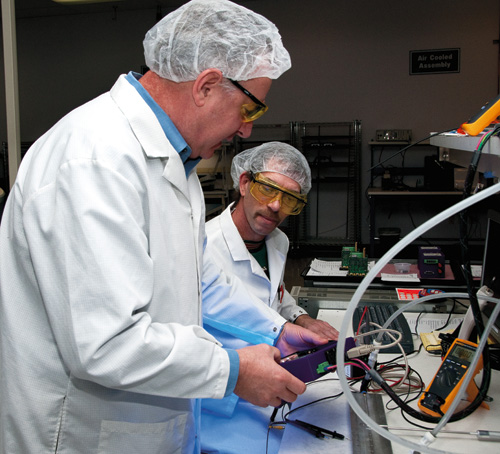 For nearly a decade Phoseon has been trying to transform the printing industry by replacing high-voltage, mercury-based bulbs used to dry and cure ink with ultraviolet LED lamps that last longer, emit less pollution, use less energy and contain no mercury.
For nearly a decade Phoseon has been trying to transform the printing industry by replacing high-voltage, mercury-based bulbs used to dry and cure ink with ultraviolet LED lamps that last longer, emit less pollution, use less energy and contain no mercury.
 |
Phoseon CEO Bill Cortelyou and Darrel Lawson examine one of the company’s LED lamps. // Photo by Teresa Meier |
The production floor at the newly expanded Phoseon Technology headquarters glows with purple light as workers go about the task of building and testing lamps. The purple creates a nice ambience, but its real purpose is deeper.
For nearly a decade Phoseon has been trying to transform the printing industry by replacing high-voltage, mercury-based bulbs used to dry and cure ink with ultraviolet LED lamps that last longer, emit less pollution, use less energy and contain no mercury. For years the company made a clean tech argument for its products similar to that of the solar and wind power industries. As in, yes, the product is more expensive, but…
Not any more. After years of research and development and 50 patents filed for or approved, CEO Bill Cortelyou says Phoseon lamps are as powerful as mercury lamps and similarly priced. “Our lamps today are 10 times more powerful than they were four years ago,” he says. “We used to have to push the product into the marketplace. Now we’re feeling a pull.”
Launched in 2002 and backed with venture capital, Phoseon reached profitability in 2009. Cortelyou, a former vice president of operations for IDT, first invested in the company in 2004 and took over as CEO in 2006. Phoseon grew from 24 to 34 employees in 2010 and Cortelyou expects 50 jobs and 3,000-4,000 lamps shipped by the end of 2011. His goal is to build a $70 million to $80 million business employing 250-300 people.
That could happen if the printing industry makes the shift from mercury to LED. About 60% of Phoseon’s business is in printing, and Cortelyou sees a billion-dollar market in replacing the printing industry’s mercury bulbs with LED lamps. The technology also has applications curing and drying adhesives and lacquer in the automotive, furniture and electronics industries.
Beyond that, Cortelyou sees vast potential in thin-film solar panels, organic LED computer monitors and other futuristic products. “The mercury lamp is fragile, high voltage and large,” he says. “If you can substitute that with something smaller and more efficient you can start doing all sorts of things that weren’t feasible before… The growth in this business is going to be all of the things we never thought of.”



